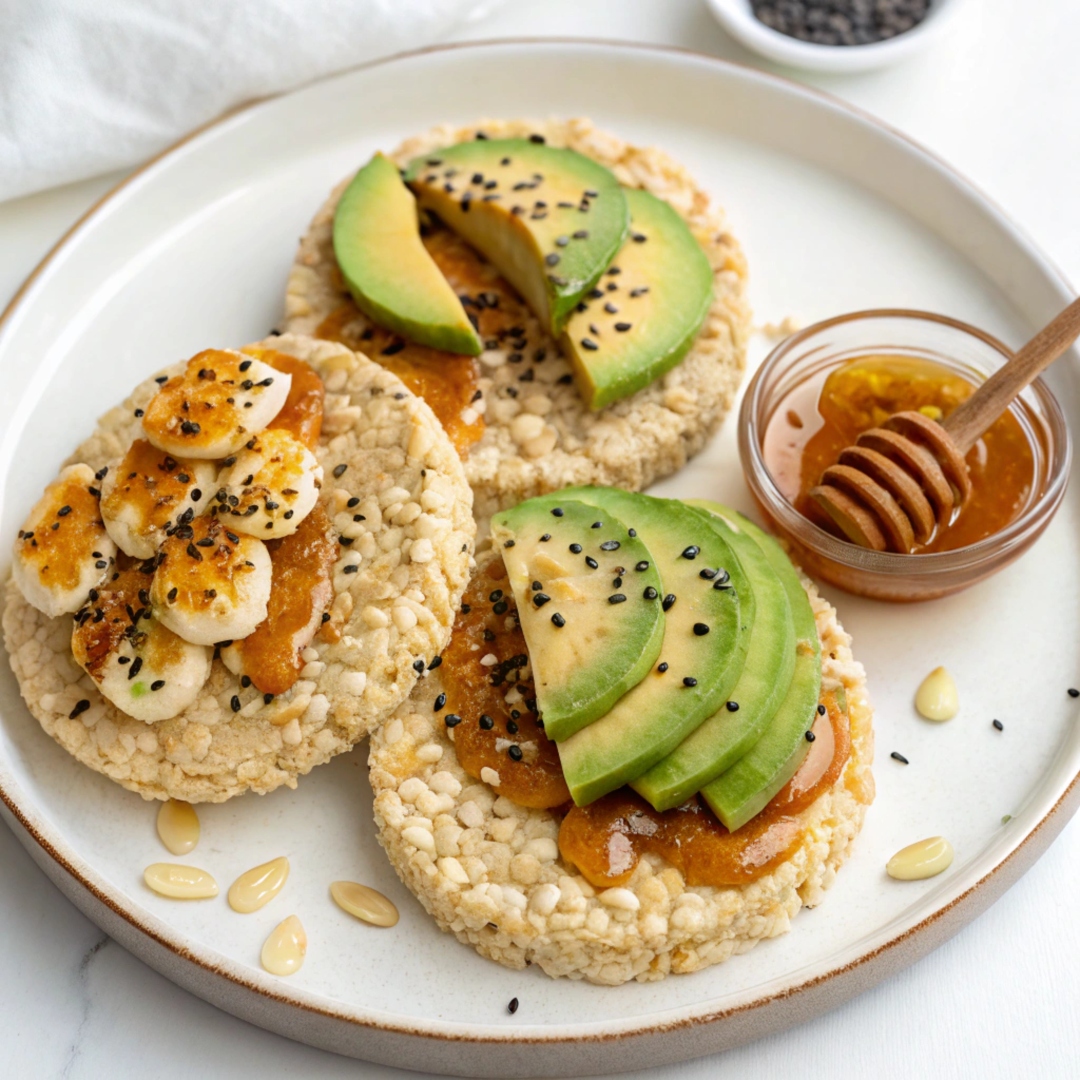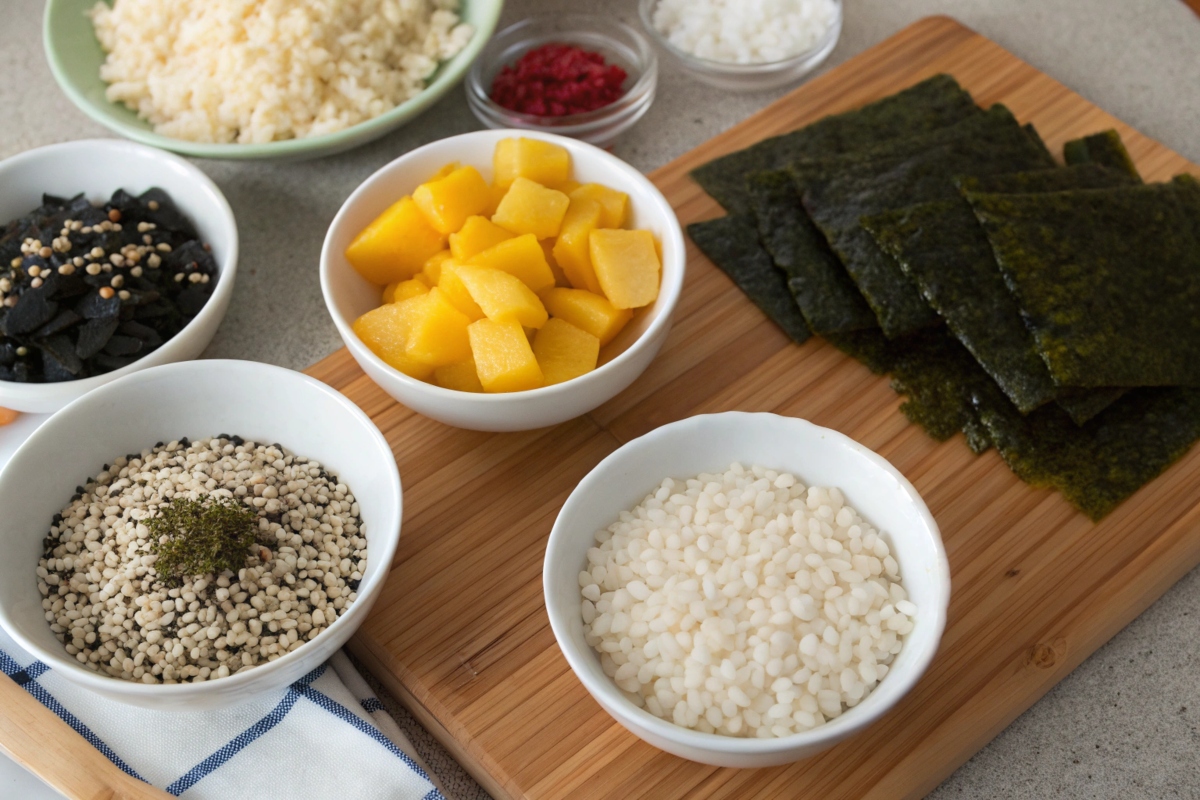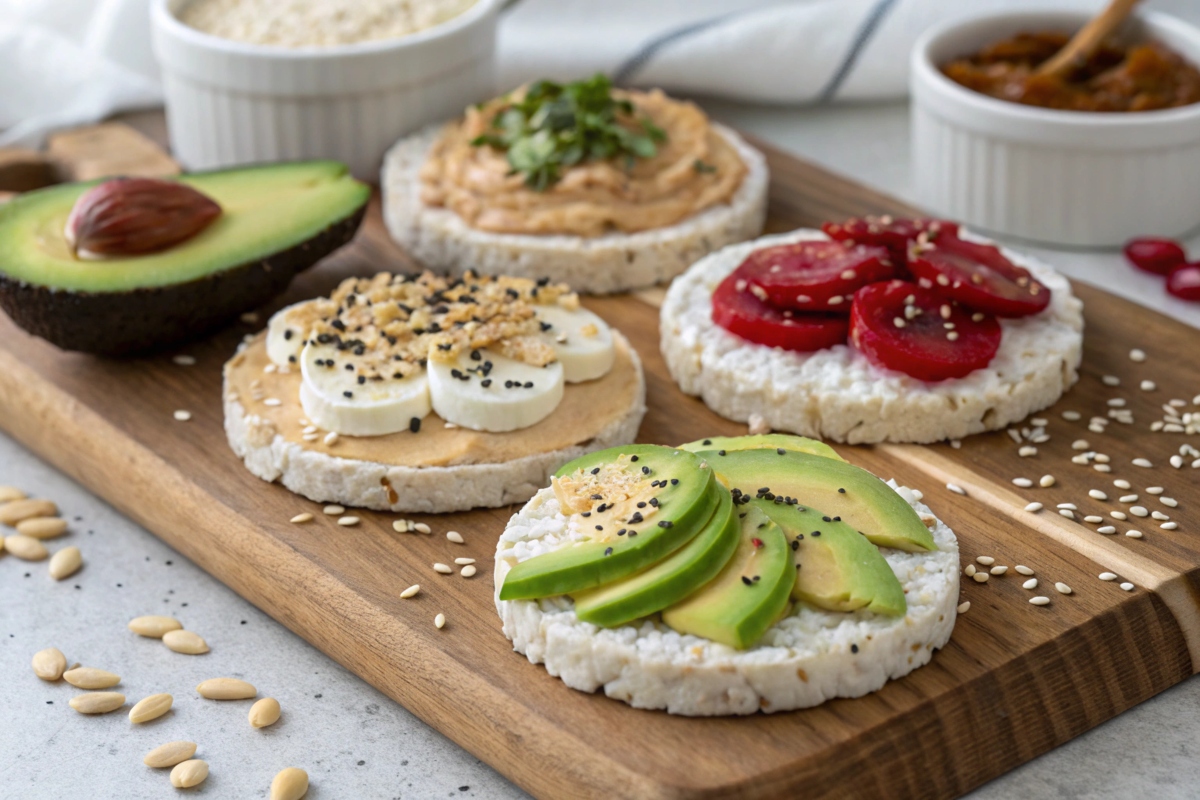Rice cakes Benefits Recipes are a popular and versatile snack enjoyed by people across the globe. Made by compressing puffed rice grains into flat, round cakes, rice cakes are light, crispy, and perfect for various culinary uses.
Historically, the origins of rice cakes date back centuries to Asian countries where rice is a dietary cornerstone. Over time, they have gained global popularity due to their simplicity and adaptability. One key reason for their widespread appeal is their ability to pair with a wide range of toppings, making them suitable for different meals and snacks. For instance, plain rice cakes are perfect for light snacking, while flavored varieties add a unique twist to this traditional food. In conclusion, rice cakes are a delightful and versatile way to enjoy the goodness of rice.
Types of Rice Cakes Recipes Around the World
Rice cakes come in many forms, reflecting the diverse culinary traditions of the world. Each type offers unique flavors and textures:
- Asian Rice Cakes: In countries like Japan, Korea, and China, rice cakes are a traditional food. For instance, mochi, made from glutinous rice, is a chewy Japanese delicacy. In Korea, tteok includes varieties ranging from savory to sweet.
- European Rice Cakes: These are often puffed rice snacks, commonly found in supermarkets. They are light, crispy, and typically enjoyed with spreads or toppings.
- Southeast Asian Rice Cakes: In Indonesia, ketupat is a compressed rice cake wrapped in woven palm leaves, often served with savory dishes.
- Latin American Variations: While not identical to traditional rice cakes, some regions create similar snacks using puffed grains or rice flour.
The wide array of rice cakes ensures there is something for every palate, whether you prefer sweet or savory options.
Nutritional Value of Rice Cakes Recipes
Rice cakes are a low-calorie food, making them a popular choice among those looking for light snacks. A standard serving contains approximately 35-60 calories per cake, depending on the size and ingredients. Rice cakes are naturally gluten-free, making them an excellent option for individuals with gluten intolerance or celiac disease.
Here’s a breakdown of the nutritional value:
- Carbohydrates: As a primary source of energy, rice cakes provide easily digestible carbs.
- Fiber: Some varieties, especially whole-grain options, offer dietary fiber for better digestion.
- Low Fat Content: Most rice cakes are nearly fat-free, unless additional ingredients like oils are added.
- Micronutrients: While plain rice cakes are not rich in vitamins or minerals, enriched varieties may include added nutrients.
However, rice cakes alone may not be sufficient as a complete meal. Pairing them with nutrient-rich toppings like avocado, hummus, or nut butter can create a balanced snack. For a delicious spin on rice cakes, try this cheesy rice recipe. It combines the simplicity of rice with a rich and creamy cheese blend, turning a simple dish into a comfort food delight.
Health Benefits of Rice Cakes Recipes
Rice cakes benefits recipes are low in calories, which makes them an excellent choice for weight-conscious individuals. Moreover, rice cakes are gluten-free and low in fat, making them suitable for those with dietary restrictions. To make rice cakes more filling, pair them with nutrient-rich toppings like almond butter or hummus.
- Weight Management: Rice cakes are low in calories and can satisfy cravings without adding excessive calories to your diet.
- Digestive Health: Whole-grain rice cakes contain fiber, which supports gut health and aids in regular bowel movements.
- Allergy-Friendly: Being gluten-free, they’re a safe option for individuals with gluten allergies or sensitivities.
- Convenience: Their portability makes rice cakes a great on-the-go snack for busy lifestyles.
- Versatility: From sweet toppings like honey to savory spreads like guacamole, rice cakes suit a variety of dietary preferences.
To maximize the rice cakes benefits recipes, choose minimally processed rice cakes with little to no added sugar or sodium. This ensures you’re enjoying a wholesome, healthy snack. Experimenting with recipes like this chicken rice broccoli dish can elevate your rice cake experience, making it a wholesome and satisfying meal option.
How to Incorporate Rice Cakes Recipes Into Your Diet
Integrating rice cakes into your daily meals is both easy and fun. Their neutral flavor serves as a perfect base for creative toppings and combinations. Here are some ideas to try:
- Breakfast: Spread peanut butter and top with banana slices for a quick and nutritious start to your day.
- Lunch: Use rice cakes as a substitute for bread in open-faced sandwiches, adding turkey, lettuce, and tomato.
- Snack: Top rice cakes with hummus, cucumber slices, and a sprinkle of paprika for a satisfying mid-day bite.
- Dessert: Spread cream cheese and drizzle with honey for a light yet indulgent treat.
You can also crush rice cakes and use them as a gluten-free breadcrumb alternative in recipes. Whether as a standalone snack or a part of your meal, rice cakes offer endless possibilities for customization and enjoyment.
Ingredients For Rice Cakes Recipes
1. Traditional Korean Rice Cakes (Tteok)
These are steamed and chewy rice cakes.
Ingredients:
- 2 cups glutinous rice flour (sweet rice flour)
- 2/3 cup water
- 1/4 tsp salt
- Optional: sugar or food coloring for variations
Steps:
- Prepare the Dough: In a mixing bowl, combine the rice flour, water, and salt. Mix until it forms a smooth, thick batter.
- Steam the Dough: Place the dough in a heatproof dish lined with parchment paper. Steam for 20-25 minutes over medium heat.
- Knead the Dough: Remove the steamed dough and knead it on a surface dusted with rice flour to make it smooth and pliable.
- Shape: Roll into desired shapes, like cylinders or flattened discs.
- Serve: Tteok can be served plain, grilled, or added to soups (like Tteokguk).
2. Crispy Rice Cakes (Snack Variety)
These are light and crunchy, often found as snack cakes.
Ingredients:
- 2 cups cooked rice (white or brown)
- 1/4 tsp salt
- Optional: spices, herbs, or sugar for flavor
Steps:
- Preheat Oven: Set the oven to 350°F (175°C).
- Shape the Cakes: Spread the cooked rice into small, flat circles on a baking sheet lined with parchment paper.
- Bake: Bake for 10-15 minutes, flip them, and bake for another 10-15 minutes until crispy.
- Cool: Let them cool and enjoy plain or with toppings.
3. Japanese Mochi Rice Cakes
These are sweet and chewy rice cakes.
Ingredients:
- 2 cups glutinous rice flour (Mochiko)
- 1 cup sugar
- 1 3/4 cups water
- Cornstarch for dusting
Steps:
- Mix Ingredients: Combine the rice flour, sugar, and water in a microwave-safe bowl. Mix until smooth.
- Cook the Dough: Microwave the mixture in intervals of 2-3 minutes, stirring in between, until it becomes thick and sticky.
- Dust and Shape: Dust your surface with cornstarch, transfer the dough, and shape it into small balls or discs.
- Optional: Fill with red bean paste or serve plain.
4. Homemade Fried Rice Cakes (Western Style)
These are versatile, using leftover rice for a crispy snack.
Ingredients:
- 2 cups cooked rice
- 1 egg
- Salt and spices to taste
- Oil for frying
Steps:
- Mix Ingredients: Combine cooked rice, egg, and seasonings in a bowl. Mix until well-combined.
- Shape the Cakes: Form the mixture into small patties.
- Fry: Heat oil in a skillet and fry the patties until golden brown on both sides.
- Serve: Serve warm with your favorite sauce or as a side dish.
Each method allows for customization, so you can adjust flavors and ingredients to your taste!
Rice Cakes Recipes in Cultural Traditions
Rice cakes have deep cultural significance in many societies, often tied to rituals and celebrations. For instance, in Japan, mochi is traditionally consumed during the New Year to symbolize health and prosperity. Similarly, Korea’s tteok is a staple in festive occasions such as weddings and birthdays, signifying happiness and unity.
In Southeast Asia, rice cakes like ketupat are integral to celebrations such as Eid, where they are served with savory dishes. In China, nian gao rice cakes are a customary food during Lunar New Year, believed to bring good fortune. Each culture’s unique preparation and presentation of rice cakes reflect the importance of rice as a unifying dietary element.
These traditions not only highlight the adaptability of rice cakes but also their role in bringing people together across different cultures and festivities.
Creative Recipes Using Rice Cakes Recipes
Transforming rice cakes into exciting dishes is a fun way to experiment in the kitchen. Here are some recipe ideas:
- Savory Rice Cake Pizza: Use rice cakes as a base, spread tomato sauce, and top with cheese and vegetables before heating.
- Rice Cake Nachos: Layer rice cakes with melted cheese, beans, jalapeños, and sour cream for a unique snack.
- Sweet Rice Cake Treats: Drizzle rice cakes with melted chocolate and sprinkle with crushed nuts for a quick dessert.
- Rice Cake Sushi: Wrap rice cakes in seaweed with avocado and smoked salmon for a creative twist.
These recipes demonstrate how versatile rice cakes can be, catering to both sweet and savory preferences. Looking for inspiration? The cream of mushroom chicken rice recipe demonstrates how rice-based ingredients can be transformed into a heartwarming dish.
Storing and Preserving Rice Cakes
Proper storage is key to maintaining the freshness and crispiness of rice cakes. Follow these tips:
- Keep Them Dry: Store rice cakes in an airtight container to prevent moisture absorption.
- Avoid Direct Sunlight: Place them in a cool, dark place to avoid exposure to heat and light.
- Freeze for Longevity: For longer storage, freeze rice cakes and thaw as needed.
With these methods, you can enjoy your rice cakes at their best quality for extended periods.
Conclusion
FAQs
Are Rice Cakes Actually Healthy?
What Are Rice Cakes Made Of?
Manufacturers make rice cakes using puffed rice. They expose rice grains to high heat and pressure, which causes the grains to expand and stick together. Some rice cakes contain only rice, while others include added ingredients like salt, sugar, or flavorings. Whole-grain rice cakes use brown rice, providing slightly more fiber and nutrients compared to those made with white rice.
Why Do Bodybuilders Eat a Lot of Rice Cakes?
Bodybuilders include rice cakes in their diets because rice cakes provide a fast and convenient source of carbohydrates. The simple carbs in rice cakes replenish glycogen stores quickly after a workout, supplying energy for muscle recovery and growth. Rice cakes contain minimal fat and digest easily, making them ideal for pre- or post-workout meals when bodybuilders need a quick energy boost.
Another reason is their versatility. Bodybuilders can easily customize rice cakes by adding protein-rich toppings like peanut butter or cottage cheese to meet their macronutrient goals.
What Is the Disadvantage of Rice Cakes?
Despite the Rice cakes Benefits Recipes there are some disadvantages:
- Low Nutritional Value: Rice cakes are low in fiber, protein, and essential vitamins and minerals. Eating them alone may not provide enough satiety or nutrition.
- High Glycemic Index: Rice cakes can cause a rapid spike in blood sugar levels, which may not be ideal for people with diabetes or those looking to maintain steady energy levels.
- Added Ingredients: Some flavored rice cakes may contain added sugars, salt, or artificial ingredients, which can diminish their health benefits.
- Not Very Filling: Because they are low in calories and nutrients, rice cakes may not keep you full for long and could lead to overeating if not paired with other foods.
To get the most out of rice cakes, choose plain or whole-grain options and combine them with nutrient-rich toppings to create a more balanced snack.




3 thoughts on “Rice Cakes Benefits Recipes: A Complete Guide”